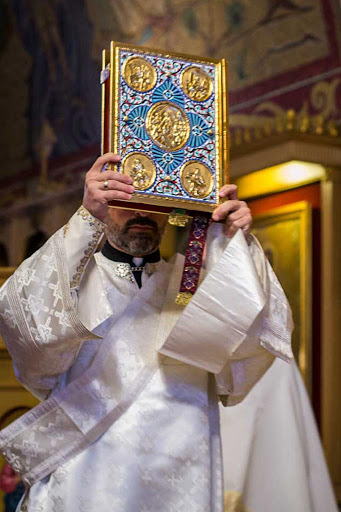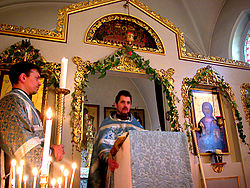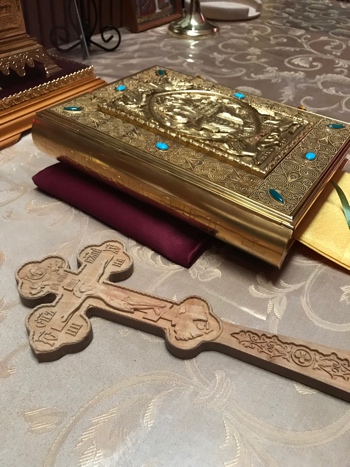The intro to last week’s Post tells how to find earlier Posts in this series.
Last week we covered the “Pro-Pro-Anaphora”, which leads us to what anciently began the Pro-Anaphora. Namely:
The Little Entrance…
…so called because it takes a short path, out the North Doors and directly to the Royal Doors. Later the Anaphora will begin with the Great Entrance, which usually takes a longer path out through the midst of the congregation to the Royal Doors. Some call these doors the “Beautiful Gates”.
Why are they usually called the “Royal Doors”? Some say because out of them comes Christ the King to speak to us in the Gospel and then later in the Holy Eucharist. Some say because in Constantinople the Emperor was allowed to enter the Altar through these doors. Maybe it’s both?
![]() Also, in passing, I trust you know that the purpose of the Iconostasis is not to hide the Altar from the people. Although the Russian Iconostasis at right certainly tries hard! Does anyone know which church this is? Rather it is to allow people to see, through these “windows into Heaven”, who is present in the Altar – not only clergy and acolytes, but also Christ and His Saints. For myself, as I said a week or two ago, I think the (very ancient and now very contemporary) somewhat open icon screen is most effective for this purpose – so people
Also, in passing, I trust you know that the purpose of the Iconostasis is not to hide the Altar from the people. Although the Russian Iconostasis at right certainly tries hard! Does anyone know which church this is? Rather it is to allow people to see, through these “windows into Heaven”, who is present in the Altar – not only clergy and acolytes, but also Christ and His Saints. For myself, as I said a week or two ago, I think the (very ancient and now very contemporary) somewhat open icon screen is most effective for this purpose – so people  will be drawn into the Altar by both “seeing in” and “seeing through”. What do you think? Left: at the opposite extreme, a very open icon screen at Saint John Cathedral, Eagle River, Alaska. Do they even have Royal Doors?
will be drawn into the Altar by both “seeing in” and “seeing through”. What do you think? Left: at the opposite extreme, a very open icon screen at Saint John Cathedral, Eagle River, Alaska. Do they even have Royal Doors?
Back to the action: This is the clergy’s formal Entrance through the Royal Doors into the Altar, the Holy Place. Anciently the clergy remained outside the Altar till this point. If you’ve been at a Hierarchical Liturgy, you noticed that the Bishop retains the older practice and doesn’t enter the Altar till now – which makes more sense.
The Pro-Anaphora is also sometimes titled “The Liturgy of the Catechumens”. In the early Church only Baptized Christians were allowed to attend the Anaphora. Even Catechumens (“Learners”, those taking formal instructions leading to Baptism) were excluded. (People were baptized, having never even seen that portion of the Liturgy!) According to the nun Egeria, in Jerusalem in the late Fourth Century these two parts of the Liturgy took place in entirely different buildings.
Why is the Gospel Book carried in the Little Entrance? Because the climax of this portion of the Liturgy will be the reading of the Holy Gospel. But originally  for a practical purpose: because of its great value, the Book was kept in a side room for safekeeping. The Deacon (if there is one) carries it because he will read it.
for a practical purpose: because of its great value, the Book was kept in a side room for safekeeping. The Deacon (if there is one) carries it because he will read it.
The Little Entrance has now also become a kind of symbolic first entrance of all the people into the first “level” of our journey into the Kingdom of Heaven. The Clergy and acolytes come out of the North Door into the church in order to “pick us all up”, so to speak, and lead us all in spirit into the Holy Place. (By this symbolism, later the Great Entrance will pass through the midst of the people, to carry all up even higher, to the very Throne of God, the Altar in Heaven.)
The Deacon cries “Wisdom! Let us attend!” “Be wise! Pay attention!” The assumption seems to be that people of Constantinople were not paying attention! were talking about the day’s race in the Hippodrome or here in Wisconsin about the Packers game. I’ve been in a couple of churches in Greece where people were definitely not “paying attention”. There was a continual buzz of conversation during the Liturgy. The Priest prays quietly: “Cause that with our Entrance there may be an Entrance of holy angels serving with us and glorifying Your goodness.”
The Troparia
After the Little Entrance come the Troparia (Apolytikia) of the Day, the Troparion of the Patron Saint of the church, and the Kontakion of the Day. These are hymns originally intended only to “fill time” till the Little Entrance was completed, since in the great church Agia Sophia in Constantinople with its many clergy, this took a long while. They have now become the “theme songs” of the day. (They compare to the Collects of the Day in Western liturgical churches.) Jesus Christ rose on Sunday, the First Day of the Week. The Orthodox Church is the Church of the Resurrection. So our first Troparion on Sundays is about the Resurrection of Christ. These are sung on an eight-week cycle. Here for example, is Tone Six. If you continue here, you can hear other Tones in both Byzantine and Russian music.
The Trisagion Hymn
Having now arrived in the Kingdom of the Father, Son and Holy Spirit, we sing the hymn of the angels, the “Trisagion” (Τρισάγιον), “thrice holy”. This is based on what Isaiah heard in his vision of Heaven: the Seraphim singing “Holy, holy, holy…” Isaiah 6 In his vision the Apostle John the Theologian also heard “Holy, holy, holy…”.
Revelation 4:8 So we we dare to join in song with the holy angels. Tradition says that this particular wording is based on a vision a boy once had in Agia Sophia. (After the Great Entrance, we will sing a different Thrice-Holy Hymn.)
The Priest prays (quietly) to the “holy God, who rests in the Holy Place, who are hymned by the Seraphim with thrice-holy cry and glorified by the Cherubim and worshipped by every heavenly power… Receive even from us sinners the Thrice-Holy Hymn…”
The Scripture Readings
Now we come to the heart of the Pro-Anaphora. Our Faith must be in accord with the Holy Scriptures or it isn’t authentically Christian, it isn’t Orthodox. By reading and hearing these Scripture readings in church, we are acting out the fact that the Bible is the Church’s book. The New Testament was written by the Church, authorized by the Church, and is interpreted by the Church out of her twenty centuries of experience with God. The Bible can only be rightly understood “in the midst of the Church”. In your personal reading and study, always read it in light of the Church’s Tradition. Take the Bible off in a corner by itself, as some do, and you will almost certainly not “get it right”. You’ll misunderstand it and may do yourself and others a lot of harm.
Anciently in some places there were at least two Old Testament readings, an Epistle and a Gospel, each often followed by a Sermon or Homily, and all separated by Psalms. A long Liturgy!
Very early we lost the Old Testament readings. (Does anyone know when? or why?) I wish we could find them again. I think our Orthodox people know far too little about the Old Testament. When Saint Paul told Timothy that “All Scripture is given by inspiration of God, and is profitable for doctrine, for reproof, for correction, for instruction in righteousness” 2 Timothy 3:16 , he meant the Old Testament. The New Testament was just then being written.
Today only little snippets of the Psalms are retained in the Liturgy. * Too bad. The Psalms were the hymnbook of the early Church. They are so rich, so profound, so deep, so beautiful. It is a great loss to our people not to hear them.
- However many Psalms are sung at Matins, Vespers and the lesser daily Hours. In traditional monasteries all 150 Psalms are sung each week, and twice a week during Lent!
The Epistles are letters from the Apostles to their flock, the Church’s first witness to the revelation of God in Jesus Christ – written and circulated even before the Gospels.  We say in the Creed that the Church is “Apostolic”. These Epistles are still the word of the Apostles to us, teaching us, inspiring us, occasionally nagging us and correcting our errors, whether in doctrine or in behavior. So now again we hear “Wisdom! Pay attention!” These Epistles have spoken directly to the hearts and souls and minds of Christians for 2000 years now. So Attend! brothers and sisters.
We say in the Creed that the Church is “Apostolic”. These Epistles are still the word of the Apostles to us, teaching us, inspiring us, occasionally nagging us and correcting our errors, whether in doctrine or in behavior. So now again we hear “Wisdom! Pay attention!” These Epistles have spoken directly to the hearts and souls and minds of Christians for 2000 years now. So Attend! brothers and sisters.
Now we come to the culmination of the Pro-Anaphora, the reading of the Holy Gospel. The word Gospel (Evangelos, ευαγγέλιο) means “Good News”. Jesus came proclaiming the Good News of salvation to the world, that God “is good and loves mankind”, that Christ has “trampled down death by death”.
To introduce the Holy Gospel we sing “Alleluia”, which in Hebrew means “Praise the Lord”, but more than that. It is another of those words that can’t be translated. Some call “Alleluia” a “numinous” word, a word that carries within itself the presence of the Holy. We can feel it, sense it, but not express it in words. That is why almost all Christians have retained the Hebrew “Alleluia”.
The Deacon (or Priest if need be) carries the Gospel Book,  out from the Altar, and the acolytes greet the Lord with lighted candles. For this isn’t just teaching. In the Gospel reading Christ comes to speak to us. We hear “Wisdom! Stand upright!” We stand in His presence. How could we not? We hear the words of Jesus Christ, we hear Jesus Christ Himself. If you listen, His words will enter into you and become part of you. My personal witness: I have read or heard the Gospel almost daily for nearly sixty years now, and it is ever more alive to me. Jesus is there.
out from the Altar, and the acolytes greet the Lord with lighted candles. For this isn’t just teaching. In the Gospel reading Christ comes to speak to us. We hear “Wisdom! Stand upright!” We stand in His presence. How could we not? We hear the words of Jesus Christ, we hear Jesus Christ Himself. If you listen, His words will enter into you and become part of you. My personal witness: I have read or heard the Gospel almost daily for nearly sixty years now, and it is ever more alive to me. Jesus is there.
“But I thought the Real Presence of Christ is in the Holy Eucharist.” Yes, certainly, but as Father Schmemann once said regarding the Divine Liturgy, “What? You think the Liturgy has only five minutes of Real Presence? Then what’s the rest of it? Real Absence?!” We Orthodox do not try to confine the presence of Christ to the Eucharist. He is “really present” everywhere. Christ is the pre-eternal God who is “in all places and fills all things”. But as someone said, “If you don’t find God somewhere, you won’t find Him anywhere.” That is why Christ came to earth and became a Man – so we could find Him “somewhere”. Now, after his Bodily Ascension, He has promised to come to us in certain places so we can easily find him there: in the Eucharist, in the Holy Gospel, in our brothers and sisters of the Church His Body, in the needy, for “Inasmuch as you have done it to the least of my brethren, you have done it to me.” 
To show how we Orthodox treasure the Gospel, how central it is to us, we normally adorn the Gospel Book with a beautiful cover and keep it always at the holiest of all possible places – at the center of the Altar table. We are saying that the Gospel of Jesus Christ is the heart of Holy Orthodoxy.
The Homily
Next comes the homily (sermon). A Bishop, Priest or Deacon proclaims the meaning of the Gospel (and also often something about the Epistle or the feast day or season). This is why the sermon was anciently placed and still belongs immediately after the Gospel reading. In some churches the sermon is placed after Liturgy, apparently because by the time of the Gospel reading many people have yet to arrive, God help us all. But I’m not going to get into that again!
The man who gives the sermon is ordained to proclaim the Church’s teachings, not his own opinions or theories. If occasionally he goes off on his own, he must make it clear that he is doing so. Fellow Orthodox clergy (if any are reading): Please take time to prepare your Homily. This is the only time most of our people will hear the Church’s teaching and the Gospel expounded. In some old world lands, Orthodoxy is just “in the air”. Not here. Christ commanded the Apostles to teach all nations “to observe all things that I have commanded you.” Matthew 28:19 So obey Him! Preach the Good News and teach the Apostolic Faith. Tell the stories of the saints. Don’t be “preachy”. Do it gently with love. Like this: Bishop Kallistos Ware at age 80.
I know. Some preachers are better than others. I have heard some truly inspiring homilies in my time, and also some truly dreadful ones. But there has never been one that I didn’t get something out of, not one in which I did not hear some word of God spoken to me. Why? I have concluded it is because sermons are more than the preacher’s words. They are “sacramental”, by which I mean God speaks through them and, if we listen, tells us what we need to hear. I have had people thank me for saying something in a sermon, which I know I didn’t say. But God did!
In the Slavic tradition now come several Litanies, which Greeks and Antiochians usually omit. Before a Litany for the Catechumens the Priest says: “Let all Catechumens depart!” Today, we do not make Catechumens leave – or anybody else. So why do we keep these lines? Well, you know…
We Antiochians do use these Litanies during Lent at the Liturgy of the PreSanctified Gifts. I’ve got to tell you this one: At Saint Nicholas, Cedarburg, I once forgot to tell a Catechumen not to leave, no matter what he heard me say. So I sang “Let all Catechumens depart”, and he got up and left! I felt so bad. Well, at least he had “paid attention”!
And so the Pro-Anaphora ends.
+ + + + + + + +
On Lenten Sundays we serve the Divine Liturgy of Saint Basil the Great. So during Lent we will conclude this series with the Anaphora of the Liturgy of Saint Basil, which is a powerful piece of writing.
Next Week: What the Pre-Lenten Epistles teach about Fasting
Week after Next: for Pre-Lenten Saturday of the Souls – The Orthodox Church’s teaching about what happens to us after we die

When you made the comment asking if the St John’s Cathedral in Eagle River has Royal Doors, I’m guessing that you were teasing. At the point in the Liturgy when this picture was taken the doors were opened and folded back on their hinges against the back of the iconostasis.
This is a really old photo because now there is a full layer of icons on top of the iconostasis that show a row of Old Testament saints. It is still a good photo to show the different styles of iconostasis that churches use. Having worshiped there at this Cathedral most of my Orthodox life, I always feel a little shut out or cut off when that curtain is pulled across the Royal Doors when attending other parishes.
No, I wasn’t teasing! I saw no sign of the Doors, and I had never heard of Royal Doors that folded. I’m glad they’re there.
From a photo on Wikipedia the grand iconostasis may that of Church of the Prophet Elias, Yaroslavl, 164 miles from Moscow
Thanks.